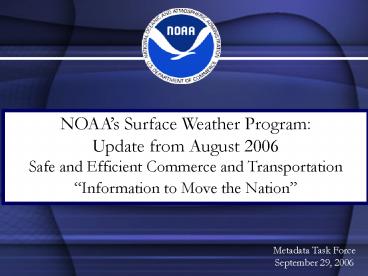ZOOM Business Plan PowerPoint PPT Presentation
1 / 16
Title: ZOOM Business Plan
1
NOAAs Surface Weather Program Update from
August 2006 Safe and Efficient Commerce and
Transportation Information to Move the Nation
Metadata Task Force September 29, 2006
2
NOAA Surface Weather Program
- NOAA is responsible for protecting life and
property and promoting safe and efficient
commerce and transportation - Weather contributes to over 7,400 fatalities,
over 700,000 injuries, and 1,500,000
weather-related - highway crashes per year
- Representing the needs of all surface
transportation sectors, i.e., roadways, rail,
transit and pipeline operations - Opportunity to improve safety
- with timely weather information
- that is transportation-relevant
3
Surface Weather within NOAAs Commerce
Transportation Goal
- Commerce and Transportation Goal / Program
management - CT Goal Lead CAPT Steven Barnum, NOAA
- Program Manager Mr. Michael Campbell, NWS
- Themes
- Safe, secure, efficient and seamless movement of
people and goods in the U.S. transportation
system - Environmentally sound development and use of the
U.S. transportation system - Port to Door
- MADIS Transition to Operations
- National Surface Weather Observing System (NSWOS)
- Within the NWS Telecommunications Gateway (NWSTG)
- MADIS transition is key to providing data
management support for CT and NWS mission - Integration of other NOAA and non-NOAA networks
- NOAA essential services and customer requirements
4
MADIS An Overview
- Data management system thats flexible,
expandable and interoperable an architecture
for the future - Provides government and non-government mesonet,
upper-air, and coastal data to NOAA and the
enterprise - Data are stratified informed by metadata
- Transitioning MADIS to the NWSTG will provide
24x7 maintenance support with offsite system
backup - Leverages NOAAs extensive data management
infrastructure and investment
5
Surface Weathers Contribution to an Integrated
Earth Observing System
- Development of the National Surface Weather
Observation System (based on MADIS
functionality) - Demonstrates the capacity to link surface-based
(land and ocean) and air observation platforms - Facilitates (via decoders, metadata, quality
control and accepted formats) the exchange of
data and information - Provides data to improve decision-makers
abilities to address pressing policy issues - Identifies gaps in our international
(continental) observational capacity.
6
NOAAs Future Data Management
Transferring the Meteorological Assimilation
Data Ingest System (MADIS) into Operations
7
The MADIS Difference
8
Operational Concept
9
Benefits of Transition
- Organizes diverse data sets from multitude of
sources into data managed sets of information
bases - Simplifies data gathering and creates 1-STOP
shopping for NOAA and it customers - Standardizes NOAAs data collection and
processing functions - Services NOAAs partners (e.g., NIDIS, DOT)
within architecture - Non-NOAA entities enthusiastic about cooperating
with NOAA - Shows good government involvement
- Reduces overall NOAA costs
- Expandable, scalable, flexible, and low-cost
solution for changing conditions and technologies - Reduces requirement for new hardware, software,
and communications
10
Program Milestones
- Milestones
- Initial Operating Capability of MADIS in NWSTG
- Full Operating Capability of MADIS (i.e., NSWOS)
in NWSTG - Add more RWIS observations
- Real-time observations from mobile sensors
available operationally
11
NOAAs Enterprise Partnerships Partnering for
Data, Improved Service
- SAFETEA-LU has fantastic potential for future of
transportation community - Thousands to millions of obs to assist decisions
- Potential for new applications
- Input to a variety of models public and private
- Supports warnings and forecasts, verification
- Data sharing
National Surface Weather Observation System -
NSWOS (Operational MADIS)
NOAA and Non-NOAA Data
Enterprise Servers
Input Output
Clarus VII Programs
Digital Database Forecast Service
Detailed, Road Section Specific Products
Watches Warnings Advisories (county/area-specif
ic)
Research, Academic, and Transportation Interface
12
Developments Reported 8/06
- NWS Transition Project Manager selected
- NWS contract support
- Planned Integrated Work Teams
- Leveraging FHWA Clarus experience
- Continued compliance with NOAA and NWS transition
policies and requirements
13
Latest Developments
- Contract support awarded
- Expertise in
- System engineering
- Blade clustering
- Documentation and requirements
14
Latest Developments
- Contractors to assist with
- Developing technical and operational requirements
- Documents required by NWS and NOAA
- Risk reduction activities in preparation of
transition - Technology demonstration as part of risk
reduction
15
Latest Developments
- Plan is to demonstrate MADIS functionality in NWS
operations as an Initial Operating Capability
(IOC) - NOAA to evolve system (NSWOS) to incorporate
expanded functionality, capabilities, and user
requirements, at Full Operating Capability (FOC) - Offsite Backup
- 24x7 operational support
16
Latest Developments
- NSWOS will meet the needs of specific
communities, but at same time NOAA wants
integration of disparate observation systems and
formats - NOAA plans to have a Users Workshop in late
FY07, to collect external requirements and
further define formats and data delivery

